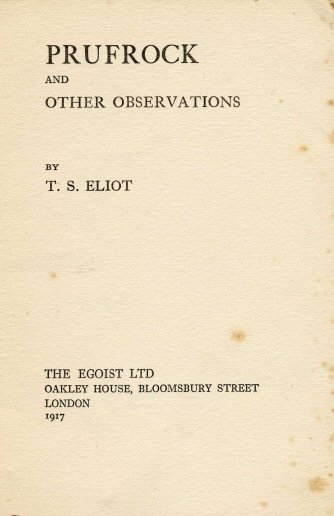
The Love Song of J. Alfred Prufrock
"The Love Song of J. Alfred Prufrock", commonly known as "Prufrock", is the first professionally published poem by American-born British poet T. S. Eliot (1888–1965). The poem relates the varying thoughts of its title character in a stream of consciousness. Eliot began writing "Prufrock" in February 1910, and it was first published in the June 1915 issue of Poetry: A Magazine of Verse[2] at the instigation of fellow American expatriate Ezra Pound. It was later printed as part of a twelve-poem chapbook entitled Prufrock and Other Observations in 1917.[1] At the time of its publication, "Prufrock" was considered outlandish,[3] but the poem is now seen as heralding a paradigmatic shift in poetry from late 19th-century Romanticism and Georgian lyrics to Modernism.
The poem's structure was heavily influenced by Eliot's extensive reading of Dante Alighieri[4] and makes several references to the Bible and other literary works—including William Shakespeare's plays Henry IV Part II, Twelfth Night, and Hamlet; the poetry of seventeenth-century metaphysical poet Andrew Marvell; and the nineteenth-century French Symbolists. Eliot narrates the experience of Prufrock using the stream of consciousness technique developed by his fellow Modernist writers. The poem, described as a "drama of literary anguish", is a dramatic interior monologue of an urban man stricken with feelings of isolation and an incapability for decisive action that is said "to epitomize [the] frustration and impotence of the modern individual" and "represent thwarted desires and modern disillusionment".[5]
Prufrock laments his physical and intellectual inertia, the lost opportunities in his life, and lack of spiritual progress, and is haunted by reminders of unattained carnal love. With visceral feelings of weariness, regret, embarrassment, longing, emasculation, sexual frustration, a sense of decay, and an awareness of aging and mortality, "Prufrock" has become one of the most recognized voices in modern literature.[6]
Description[edit]
Title[edit]
In his early drafts, Eliot gave the poem the subtitle "Prufrock among the Women."[11]: 41 This subtitle was apparently discarded before publication. Eliot called the poem a "love song" in reference to Rudyard Kipling's poem "The Love Song of Har Dyal", first published in Kipling's collection Plain Tales from the Hills (1888).[17] In 1959, Eliot addressed a meeting of the Kipling Society and discussed the influence of Kipling upon his own poetry: